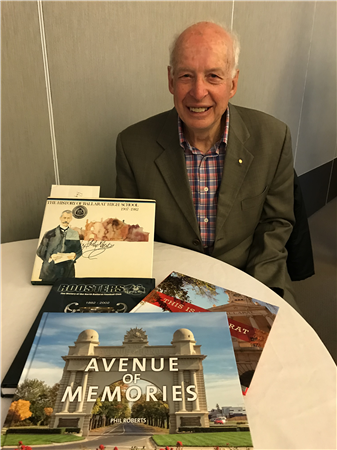Phil has written 17 history books, one a year recently. He gave us some insight into how he started out as a writer, and what he has learned.
Phil has some connections with East Gippsland, with his mother from a farm in Orbost, and her sister married to Jack Watts, manager of the Bairnsdale Butter Factory. He is one of four children, and used to come to this area each January for a family holiday. He still has an uncle living in Bairnsdale. He is proud to have ridden 117 km in a day, from Sale to Bairnsdale, with his 8 year old grandson on the Great Victorian Bike Ride, some years ago.
Phil’s first book was a history of the Ballarat High School, written to celebrate its 75thanniversary in 1981. He was a teacher at the school, and volunteered to write the book. His principal gave him one day a week off teaching for 6 months to do the research. He was on a tight schedule, and managed to write a chapter a week, to complete his first draft in time for Geoffrey Blainey, an old boy of the school, to write the forward.
He was dismayed to then attend a talk by Professor Western Bate about writing history books, where he was told that when you’ve written your first draft, you’re only half way there! At that point you have an overview of the whole topic, and can rearrange it to make it more engaging for the readers.
Phil has written 5 books about sport, including a history of the oldest golf club in Australia, still in its original location (the Ballarat Golf Course, established in 1895). He has done a history of the Roosters football club, and Royal Tennis.
He has also written five books about schools, and seven community books, including histories of the Scouts, Haymes Paints and the Agricultural and Pastoral Society.
His latest book, “Avenue of Memories” is shortlisted for the Victorian History Awards. It covers the Ballarat memorial avenue, which has been maintained by a strong committee over many years, commemorating the local soldiers, seamen, airmen and nurses who died in wars.
If all this has inspired you to write a book, Phil recommends you find your sources in newspapers, other books, interviews and on the internet. Set a realistic time for your research by working out a launch date and working backwards. It cost $30,000 to print up 900 copies of his last book.
He recommended we all keep a folder with our personal family history in it, just adding sheets as things occur so dates and places are established. Talk to older members of your family and write down details before it’s too late. Newspapers are invaluable for confirming time and place, as are diaries. Many newspapers are available online on Trove.
Phil absorbs himself in his topic by reading and doing interviews, and then writes the book “off the top of my head” so that it is in his own words, and he is telling a story. That gives the first draft, then the reworking can take place. Chronological order becomes boring for the reader, so he looks for themes and stories. He recommends discussing with others and listening to advice. You need good proof readers, and Phil relies heavily on his wife, Geraldine. He suggests having an expert in the topic read the book and also a friend or relative who knows nothing about the subject – they may pick up any areas which are unclear.
His writing has given Phil the opportunity to meet a wide selection of community members, and there is a great feeling of satisfaction when a book is finally completed.
Leah thanked Phil for his talk and wished him luck in the awards to be announced next week.

